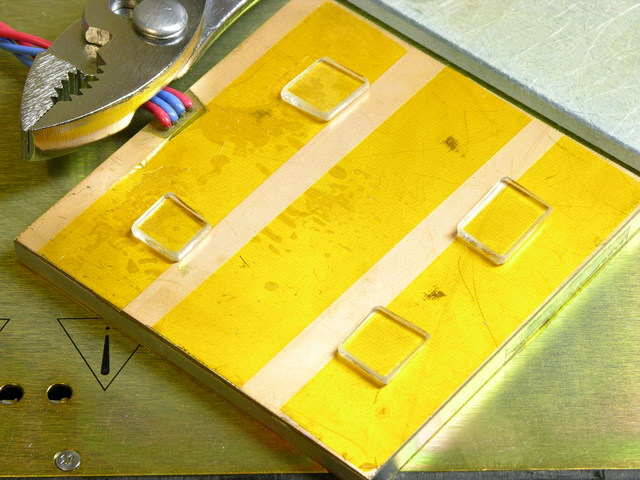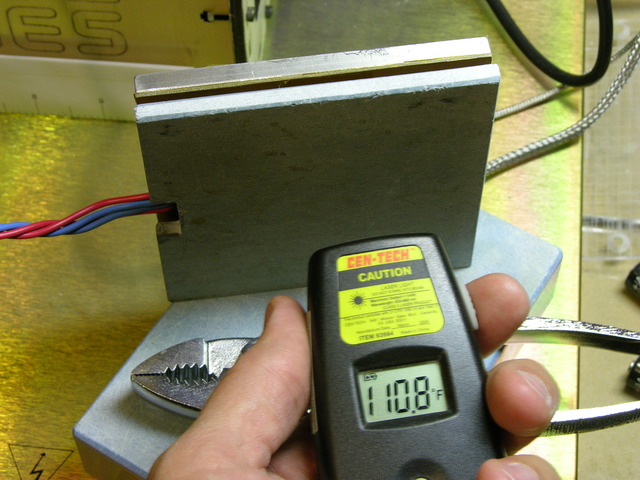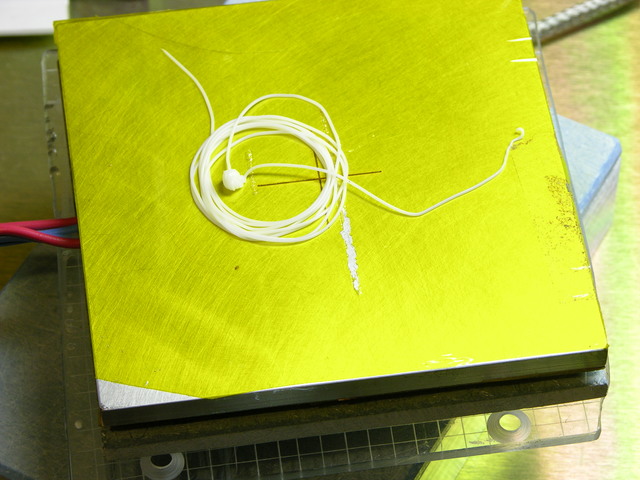As I discovered a couple of weeks ago, Glastherm HT is not a good enough insulator to protect the acrylic mounting plate under my MakerBot CupCake heated build platform. Last night I tried it with glass standoffs between the hotplate and the Glastherm.
I had some leftover glass from having a window cut recently. I bought a glass cutter and cut a half-inch strip off the end of one of the pieces, then cut that into smaller tiles. I smoothed the sharp edges on a diamond file, then pried apart the hotplate sandwich and stuck the glass tiles onto the leftover kapton tape.
I repeated my earlier test, standing the sandwich on edge on another piece of insulating material and running the heated build platform up to (and past) operating temperature. (Sorry no laser dot in the picture — I’m not quite coordinated enough to hold the thermometer’s capture button, point it the right direction, hold my hand still, and take a picture all at the same time.)
| Plate Temp | Back Max Temp | Back Min Temp |
|---|---|---|
| 120°F | 85°F | |
| 145°F | 95°F | |
| 175°F | 120°F | 105°F |
| Approximate CupCake target temperature | ||
| 220°F | 155°F | 135°F |
| 310°F | 200°F | |
The air gap did a considerably better job of insulating than the Glastherm alone. Also when I remembered to measure the temperature separately under the glass feet, the spots were 15-20°F hotter than the rest of the Glastherm, suggesting that smaller glass dots could provide a significant further reduction in heat transfer.
135°F on the back side is pretty manageable; 200°F is a bit warm to be in contact with plastic. However, as Leon pointed out last time, it’s not just about how hot the back side gets, but about how rapidly the heat is transferred into the backing material.
I set the heated platform onto a spare piece of plexiglass and also dropped some scrap filament onto the top of the platform. Already above operating temperatures, the filament softened nicely and the plexiglass stayed cool to the touch and didn’t warp. Leaving the setup unattended for a while and letting the platform drift up to 340°F, the plexi got a little soft.
I think this is usable for the CupCake, but I’ll need to exercise a little care managing the plate temperature (and I’m overdue hooking up the thermistor for closed-loop temperature control). I think this may not yet be enough insulation to tape my SMT hotplate directly on top of a plastic enclosure and run 290°C (~550°F) soldering temperatures.



Now that you have an air gap, why not blow some forced air through there? Cut some fins into the top of the glastherm layer for good measure. It would make the hotpate less efficient I guess, not that thats a huge concern if it still makes it up to temp…
I’d suggest you double up that sandwich and make a second air gap.
Be very certain the new “glass dots” do not line up with the glass dots you already have in there or you will have a direct thermal conduction path. You want the heat to have to go sideways to get from one layer of glass dots to the other.
I just started reading your blog, some very cool stuff you have going on here. I thought I’d throw in my own 2 cents…
As far as thermal insulation goes, air is one of the best so it makes sense that your glass standoffs do a good job. Heat transfer works just like current transfer, and your glass bits work just like little resistors. More to the point, you’ll double your thermal resistivity if you add another layer of glass squares.
For heating in general, the commercial RP machines I’ve seen also control the temperature in the entire chamber (not just the base surface) to around 90 degrees or so. Maybe this is ‘phase two’ of this sub project, but it would seem like this would have a greater benefit.
Keep up the great work
One hotplate design that I have studied used stainless steel standoffs and a U shaped piece of stainless sheet to support the heated stage from the sides. This seemed to work fairly well as stainless is a relatively poor conductor of heat. I doubt that the stainless was cool to the touch, but it was cool enough that the aluminum plate it was attached to (I forget if it was bolted or glued) didn’t get very warm. Something to think about…
Mica is a far better insulator than Glastherm. Thermal conductivity is far lower than Glastherm. Seems Mica lets the heat spread side to side better also.